The Making of a Legend
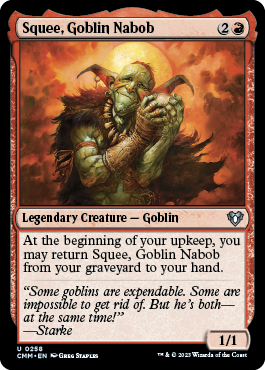 Squee, Goblin Nabob (Mercadian Masques)
Squee, Goblin Nabob (Mercadian Masques)
Squee was a challenging card to design. Market research had shown that Squee was the most popular member of the Weatherlight crew. But he was simply comic relief whose biggest joke seemed to be that he just wouldn’t die despite how many stupid things he did. How does one turn that into an exciting Magic creature?
I started by focusing on the positive. What abilities did Squee demonstrate in the story? He was easily frightened. He was a coward. And he was as dumb as a brick. Not the most evocative of profiles. I was about to give up hope when I stumbled upon the key to his character. He just wouldn’t die. (This theme was later picked up in the Magic novels where the audience learned that Squee was quite literally immortal.) Even a small creature can prove deadly if your opponent has no way to permanently rid you of the card.
Once I knew Squee was a 1/1 that couldn’t die, I began looking for mechanics to make this work. An early version:
Squee
1R
Creature – Goblin Legend
1/1
Squee cannot die.
This version of the card was killed at the time for rules issues. But then, inspired by Hammer of Bogardan, I came up with a new version. This version kept Squee “alive” by constantly allowing you to regrow him. An early playtest showed the card had great synergy with the spellshapers, a major mechanic in the block. And thus, the Squee that you all know and love was born.
As you can see, designing legends has the extra baggage that the mechanic has to make sense with the flavor. This is backwards from the way that R&D normally designs cards. You see, mechanics are much less flexible than flavor, so it is often easier to create the proper mechanic and then find a flavor that suits it. But legends don’t often let you do this (and yes, there are some exceptions further down the page). Legends make you work to find a way to make the mechanic match the flavor. This is hard work, but when it pays off, you get some very cool cads.
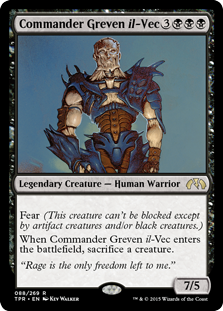 Commander Greven il-Vec (Tempest)
Commander Greven il-Vec (Tempest)
If my Hollywood days taught me anything it’s the importance of a good villain. The Tempest storyline used the time-tested strategy of using two villains: a lesser “brawn villain” reporting to a much nastier “brain villain.” Greven is clearly the “brawn villain” of Tempest. This meant that I had to make him physically impressive. In addition, I wanted to give him some mechanic that stressed how intimidating he was.
The very first thing that came to my mind was a big creature with fear. To balance out the card and to add a little flavor about how Greven has no qualms killing those around him if it benefits his agenda, I added a creature sacrifice when the creature came into play.
I was quite happy with the card as I felt it did a good job of representing the essence of Greven. Little did I know the odd fight I was about to have. Here (with a lot of dramatic license) is the conversation:
Not Me: I think we have a problem with Greven.
Me: What kind of problem?
Not Me: Vhati il-Dal.
Me: Huh?
Not Me: He can’t kill Vhati il-Dal.
Me: So?
Not Me: So, in the story, Greven kills Vhati il-Dal. He throws him over the side of the Predator. On Diabolic Edict.
Me: Yeah, yeah. “The fall will give you time to think on your failure.” I know the scene. I wrote the flavor text. I don’t understand the problem. Greven’s 7/5 and Vhati’s 3/3. How can he not kill him?
Not Me: But you’re forgetting Vhati il-Dal’s activated ability. Vhati could turn Greven into a 1/5. Or a 7/1 that he could then trade with. And remember in the story, it isn’t close. Greven kicks Vhati to the curb.
Me: Maybe Vhati has summoning sickness.
Not Me: No, no, he’s been attacking the Weatherlight for quite some time.
Me: Perhaps he’s so intimidated that he forgets to use his activated ability.
Not Me: I don’t think so. Look, we’re just going to have to scrap the card.
Me: That’s crazy. It’s a good card.
Not Me: Not if it can’t kill Vhati.
Me: Wait, I got it. When Greven comes into play, you sacrifice Vhati. Like when he shows up on the Predator and there goes Vhati. Vhati dies to the sacrifice effect. He can’t stop that.
Not Me: But for that to happen, both creatures have to be on the same side.
Me: Same side. Exactly. Just like the story.
(Pause.)
Not Me: I like it.
Greven demonstrates how the flavor can extend beyond the original card to its interaction with other story cards.
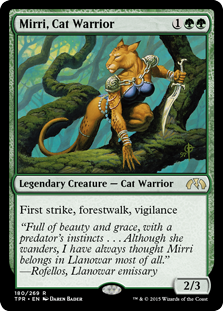 Mirri, Cat Warrior (Exodus)
Mirri, Cat Warrior (Exodus)
Sometimes, story is able to change mechanics. Mirri’s creation is one such incident. While designing Exodus, we knew we had to create a Mirri legend as Mirri died during the Exodus story. We had promised to print all of the major Weatherlight crew as legends so this was our last chance for Mirri.
Mirri was a cat warrior that lived with the Llanowar Elves. In addition, she was a strong fighter. To capture this flavor we decided to give her four abilities: first strike, forestwalk, protection from black, and does not tap to attack. But there was a story problem that I brought up:
Not Them (aka Me): We can’t print Mirri as is.
Them: Why not?
Not Them: Because Mirri can’t have protection from black.
Them: Once again, why not?
Not Them: Because she’s killed by Crovax the Cursed. Them: So?
Not Them: He’s a black creature from Stronghold.
(Blank stare from Them.)
Not Them: A black creature really has a hard time killing a creature with protection from black. I suggest either changing the protection ability or rewriting the story to have Mirri laugh while Crovax tries to kill her.
In the end, we changed protection from black to “cannot be the target of spells or abilities”. But then in typesetting the card proved to be too long so we had to trade untargetability for a third point of toughness.
Glissa Sunseeker (Mirrodin)
This card was a tough nut to crack. In the story, Glissa played into two different aspects of green that haven’t interacted all that often. So, it seemed obvious that I wanted to find a way to interweave the two abilities. I was having trouble until I decided to think outside the box a little. Who said…
Wait a minute, this is August and the previews for Mirrodin start in September. Which means that I… Oops. Please ignore the last two paragraphs. They don’t exist. Yeah I know you’re reading it right now. Figment of your imagination.
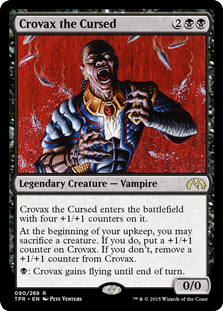 Crovax the Cursed (Stronghold)
Crovax the Cursed (Stronghold)
I came up with the mechanic for this card during Mirage development. I loved the idea of a vampire that had to feed each turn that got stronger when he fed and weaker when he didn’t. We ended up using a different vampire mechanic in Mirage so I back-pocketed the idea for a later time. I knew it was only a matter of time before we made another vampire.
Once we created Crovax, I knew I had found a place for my vampire mechanic. Originally this card was in Tempest, but when we realized that Crovax couldn’t start out as a vampire (the crew would be fools to invite a vampire to join them on their quest), the card got pushed back to Stronghold, where Crovax’s cursing, and subsequent transformation, would occur.
 Karn, Silver Golem (Urza’s Saga)
Karn, Silver Golem (Urza’s Saga)
Karn got his special ability from the wildest of places: Vanguard. Let me explain. When we first created Vanguard (a selection of meta cards that allow you to shift certain dynamics of the game – click here for examples), we decided to name each of the cards after a member of the Weatherlight Saga. We chose to make the Titania's Song card Karn as he was the only character that had anything to do with artifacts. He’s part of the Legacy, we rationalized, perhaps he has some natural ability to enliven artifacts. (The novels would later grant him this ability.)
So when it came time to design his card, we turned to the Vanguard card for inspiration. We kept the same basic concept but turned the effect into an activated ability that only lasted until the end of the turn. The –4/+4 rider was added, incidentally, because we wanted to him to appear buff but not kill other creature in combat as he was a staunch pacifist that refused to harm others.
The point of this example is to show how the inspiration for legends can come from anywhere.
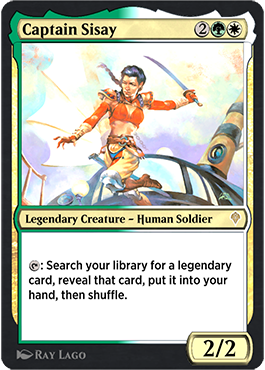 Captain Sisay (Invasion)
Captain Sisay (Invasion)
This card is the perfect example of a mechanic that flowed out of the card’s flavor. Sisay is the captain of the Weatherlight. Her mission was to crew the flying ship and seek out the artifacts of the Legacy. In short, she was a seeker of legends and legendary things. This card helps demonstrate that legends are often at their best when the flavor has an easy mechanical parallel.
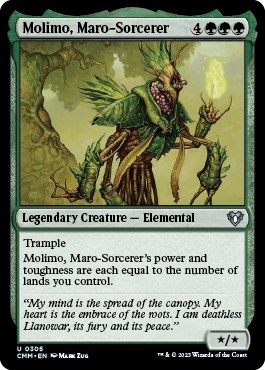 Molimo, Maro-Sorcerer (Invasion)
Molimo, Maro-Sorcerer (Invasion)
If you ever wondered what happened to Dakkon Blackblade, I can tell you. He was reincarnated as a nature elemental. You see, when we were designing Invasion we were trying to come up with some neat ideas for legends. This led us to talk about old legends we’d enjoyed. At one point I mentioned Dakkon. I said that he was really cool and that one day, we should redo him in a slightly tweaked version. To that Bill Rose replied, “Well, why not now?”
We changed him from his odd three color combination (black, blue and white – funny as his flavor text includes the line: “my strength is that of mountains”) to a mono-color that made sense for the ability. It was only later in the process that the card got turned into a maro-sorcerer.
Sometimes legends get created because we have splashy mechanics that seem to want the extra cache that making them a legend adds.
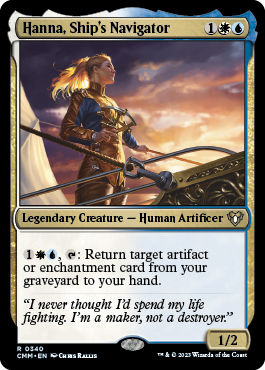 Hanna, Ship’s Navigator (Invasion)
Hanna, Ship’s Navigator (Invasion)
This is another case of a legend that is the reincarnation of an old time favorite. This time I borrowed from Antiquities with the card Argivian Archaeologist. The tweak to the repeat was to make it a multi-colored card that could regrow enchantments as well as artifacts.
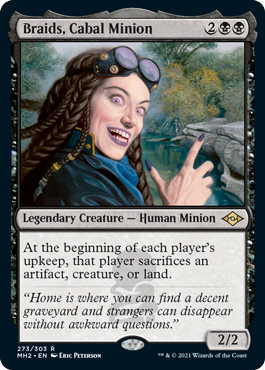 Braids, Cabal Minion (Odyssey)
Braids, Cabal Minion (Odyssey)
The most interesting thing about this card was that it wasn’t designed to be a legend. Mike Elliott created the card to be sort of a portable black hole. But during development, the team realized that they wanted to include Braids in Odyssey. While trying to find a rare card to cut to make space for Braids, the team realized that that one of the pre-existing cards somehow had already captured Braids' flavor. So, the card was turned into Braids. The importance of this little story is to show that there’s no one way to design a legend. Sometimes legends are created and sometime legendary status is thrust upon them.
Legend In My Own Mind
As you can see, designing legends is not as straightforward as it might first appear. Hopefully, my stories today will give you a little peek into the various creative endeavors that result in the legends you all know and love.
Join me next week when I begin dipping my toe into the wonderful world of Mirrodin.
Until then, may your beatstick have a nice name and an interesting backstory.
Mark Rosewater
Mark may be reached at makingmagic@wizards.com.
